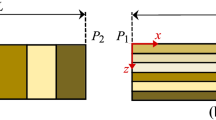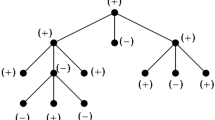Abstract
The interfacial capillary–gravity waves due to a transient fundamental singularity immersed in a system of two semi-infinite immiscible fluids of different densities are investigated analytically for two- and three- dimensional cases. The two-fluid system, which consists of an inviscid fluid overlying a viscous fluid, is assumed to be incompressible and initially quiescent. The two fluids are each homogeneous, and separated by a sharp and stable interface. The Laplace equation is taken as the governing equation for the inviscid flow, while the linearized unsteady Navier–Stokes equations are used for the viscous flow. With surface tension taken into consideration, the kinematic and dynamic conditions on the interface are linearized for small-amplitude waves. The singularity is modeled as a simple mass source when immersed in the inviscid fluid above the interface, or as a vertical point force when immersed in the viscous fluid beneath the interface. Based on the integral solutions for the interfacial waves, the asymptotic wave profiles are derived for large times with a fixed distance-to-time ratio by means of the generalized method of stationary phase. It is found that there exists a minimum group velocity, and the wave system observed will depend on the moving speed of the observer. Two schemes of expansion of the phase function are proposed for the two cases when the moving speed of an observer is larger than, or close to the minimum group velocity. Explicit analytical solutions are presented for the long gravity-dominant and the short capillary-dominant wave systems, incorporating the effects of density ratio, surface tension, viscosity and immersion depth of the singularity.
Similar content being viewed by others
References
Chwang AT and Wu TYT (1975). Hydromechanics of low-Reynolds-number flow. Part 2. Singularity method for Stokes flows.. J Fluid Mech 67: 787–815
Pozrikidis C (1989). A singularity method for unsteady linearized flow. Phys Fluids A 1: 1508–1520
Shatz LF (2004). Singularity method for oblate and prolate spheroids in Stokes and linearized oscillatory flow. Phys Fluids 16: 664–677
Happel J and Brenner H (1973). Low Reynolds Number Hydrodynamics. Noordhoff International Publishing, Leyden, 79–82
Olmstead WE and Gautesen AK (1976). Integral representations and the Oseen flow problem. Mech Today 3: 125–190
Venkatalaxmi A, Padmavathi BS and Amaranath T (2004). A general solution of unsteady Stokes equations. Fluid Dyn Res 35: 229–236
Shu JJ and Chwang AT (2001). Generalized fundamental solutions for unsteady viscous flows. Phys Rev E 63: 051201
Lu DQ and Chwang AT (2004). Free-surface waves due to an unsteady Stokeslet in a viscous fluid of infinite depth. In: Cheng, L and Yeow, K (eds) Proceedings of the 6th international conference on hydrodynamics, Perth, Western Australia, 24–26 November 2004, pp 611–617. Taylor & Francis Group, London
Lu DQ and Chwang AT (2005). Unsteady free-surface waves due to a submerged body moving in a viscous fluid. Phys Rev E 71: 066303
Chen XB and Wu GX (2001). On singular and highly-oscillatory properties of the Green function for ship motions. J Fluid Mech 445: 77–91
Raphaël E and de Gennes PG (1996). Capillary gravity waves caused by a moving disturbance: wave resistance. Phys Rev E 53: 3448–3455
Richard D and Raphaël E (1999). Capillary gravity waves: The effect of viscosity on the wave resistance. Europhys Lett 48: 49–52
Lu DQ and Chwang AT (2005). Interfacial waves due to a singularity in a system of two semi-infinite fluids. Phys Fluids 17: 102107
Lu DQ and Chwang AT (2007). Interfacial viscous ship waves near the cusp lines. Wave Motion 44: 563–572
Lu DQ, Wei G and You YX (2005). Unsteady interfacial waves due to singularities in two semi-infinite inviscid fluids. J Hydrodynam B 17: 730–736
Palaniappan D (2000). General slow viscous flows in a two-fluid system. Acta Mech 139: 1–13
Prosperetti A and Cortelezzi L (1982). Small-amplitude waves produced by a submerged vorticity distribution on the surface of a viscous liquid. Phys Fluids 25: 2188–2192
Miles JW (1968). The Cauchy–Poisson problem for a viscous liquid. J Fluid Mech 34: 359–370
Debnath L (1969). On effect of viscosity on transient wave motions in fluids. Int J Eng Sci 7: 615–625
Prosperetti A (1976). Viscous effects on small-amplitude surface waves. Phys Fluids 19: 195–203
Wu GX, Eatock Taylor R and Greaves DM (2001). Viscous effect on the transient free surface flow in a two dimensional tank. J Eng Math 40: 77–90
Chen XB, Duan WY (2003) Capillary-gravity waves due to an impulsive disturbance. In: Clement AH, Ferrant P (eds) Proceedings of the 18th international workshop on water waves and floating bodies, Ecole Centrale de Nantes, France, 6–9 April 2003, pp 29–32
Chen XB (2002) Role of surface tension in modelling ship waves. In: Rainey RCT, Lee SF (Eds) Proceedings of the 17th international workshop on water waves and floating bodies, Peterhouse, Cambridge, UK, 14–17, April 2002, pp 25–28
Chen XB, Lu DQ, Duan WY and Chwang AT (2006). Potential flow below the capillary surface of a viscous fluid. In: Linton, CM, McIver, M, and McIver, P (eds) Proceedings of the 21st international workshop on water waves and floating bodies, Loughborough, UK, 2–5 April 2006, pp 13–16. Department of Mathematical Sciences, Loughborough University, Leicestershire
Chen XB, Duan WY and Lu DQ (2006). Gravity waves with effect of surface tension and fluid viscosity. J Hydrodynam 18(3(Suppl.)): 171–176
Stoker JJ (1957). Water waves: the mathematical theory with applications. Interscience Publishers, New York, pp 163–168
Mei CC (1994). The applied dynamics of ocean surface waves. World Scientific Publishing, Singapore
Lu DQ and Dai SQ (2006). Generation of transient waves by impulsive disturbances in an inviscid fluid with an ice-cover. Arch Appl Mech 76: 49–63
Nayfeh AH (1981). Introduction to perturbation techniques. Wiley-Interscience, New York
Scorer RS (1950). Numerical evaluation of integrals of the form \(I = \int_{x_1}^{x_2} f(x){\rm e}^{i\phi(x)}{\rm d}x\) and the tabulation of the function \({\rm Gi}(z) = (1/\pi) \int_0^{+\infty} \sin (uz+\frac{1}{3}u^3) {\rm d}u \). Quart J Mech Appl Math 3: 107–112
Abramowitz M and Stegun IA (1972). Handbook of mathematical functions with formulas, graphs and mathematical tables. National Bureau of Standards, Washington, DC
Author information
Authors and Affiliations
Corresponding author
Rights and permissions
About this article
Cite this article
Lu, D.Q., Ng, CO. Interfacial capillary–gravity waves due to a fundamental singularity in a system of two semi-infinite fluids. J Eng Math 62, 233–245 (2008). https://doi.org/10.1007/s10665-007-9199-6
Received:
Accepted:
Published:
Issue Date:
DOI: https://doi.org/10.1007/s10665-007-9199-6




